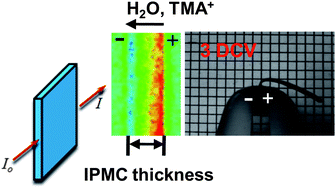Electrically stimulated gradients in water and counterion concentrations within electroactive polymer actuators
Abstract
While

* Corresponding authors
a
The Macromolecules and Interfaces Institute, Department of Chemistry, Virginia Polytechnic Institute and State University, Blacksburg, VA, USA
E-mail:
rbmoore3@vt.edu
b School of Polymers and High Performance Materials, The University of Southern Mississippi, Hattiesburg, MS, USA
c Polymers Division, National Institute of Standards and Technology, Gaithersburg, MD, USA
d NIST Center for Neutron Research, National Institute of Standards and Technology, Gaithersburg, MD, USA
While

 Please wait while we load your content...
Something went wrong. Try again?
Please wait while we load your content...
Something went wrong. Try again?
J. K. Park, P. J. Jones, C. Sahagun, K. A. Page, D. S. Hussey, D. L. Jacobson, S. E. Morgan and R. B. Moore, Soft Matter, 2010, 6, 1444 DOI: 10.1039/B922828D
To request permission to reproduce material from this article, please go to the Copyright Clearance Center request page.
If you are an author contributing to an RSC publication, you do not need to request permission provided correct acknowledgement is given.
If you are the author of this article, you do not need to request permission to reproduce figures and diagrams provided correct acknowledgement is given. If you want to reproduce the whole article in a third-party publication (excluding your thesis/dissertation for which permission is not required) please go to the Copyright Clearance Center request page.
Read more about how to correctly acknowledge RSC content.
 Fetching data from CrossRef.
Fetching data from CrossRef.
This may take some time to load.
Loading related content
